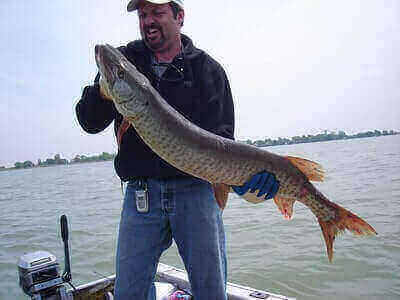Disclosure: We may earn commissions if you purchase products after clicking on a link from our site.
Do you want muskie fishing tips for beginners? Do you want to learn how to catch more muskies? Muskies are one of the most elusive and sought-after fishes. Called the fish of 10,000 casts, it is not the easiest of fish to catch. In this article, we muskie fishing tips that beginners, as well as experienced fishermen, can use to take home that trophy muskie.
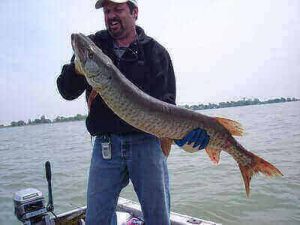
Table of Contents
- 1 How To Catch Muskie
- 2 Muskie Fishing Tackle
- 3 Muskie Fishing Tips For Beginners
- 4 How To Catch Muskie From Shore
- 5 How To Catch Muskie In Summer
- 6 How To Catch Muskie In A River
- 7 How To Catch Muskie In Winter
- 8 How To Catch Muskie Ice Fishing
- 9 How To Catch Muskie On Lake St. Clair
- 10 Muskie Fishing Gear
- 11 Musky Fishing Baits
- 12 The Bottom Line
How To Catch Muskie
1. Casting
Casting is the most popular fishing method for catching muskies. Most anglers cast for muskies from a boat using artificial lures. Casting from a slow-moving boat can be effective for anglers as it lets the angler cover a lot of water in a short period of time.
2. Trolling
Trolling can also be used to fish for muskies. Crankbaits are one of the lures used by anglers to fish for muskies when trolling from a boat. When trolling, the angler can move over reefs, rocky points, and weed lines.
Muskie Fishing Tackle
Heavy tackle is the preferred choice for the fishing tackle when fishing for muskies. A 7- to 9-foot rod with a bait-casting reel and a heavy braided line of 50-pound test.
Muskie Fishing Tips For Beginners
1. Find the bait, find the muskies. Muskies are said to be concerned about only two things: spawning and eating. If you can find their bait, you will locate muskies. This is one of the best muskie fishing tips for beginners.
2. Visit the Division of Natural Resources website of the state you plan to fish in. You will find lakes, rivers, and creeks that may have muskies. This site will inform you if muskies are in the bodies of water in that state.
3. Fish the shallow sand or weed flats with glide baits, crankbaits, swimbaits, and soft plastics when the weather is mild or there is a warming trend. When the temperature drops, use the same baits to fish for muskies.
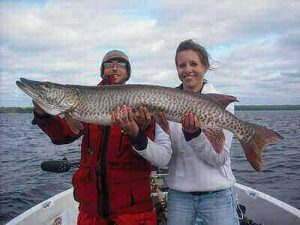
4. Fishing for muskies during a full moon gives you an advantage. For daytime fishing, choose a day with a new or full moon. Similarly, for nighttime fishing, fish a night with a full moon. It may seem weird to connect the phases of the moon with fishing, but the phases of the moon indeed affect fish and other animals. Remember this muskie fishing tip for beginners, implement it, and observe your fishing results.
5. Use a heavy, braided line with a pound test between 80 and 100. The higher a line’s “pound test” is, the stronger it will be. Connect the line to the lure with a steel or heavy fluorocarbon leader since muskies have sharp teeth.
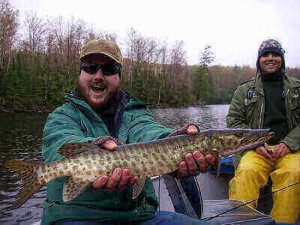
6. Don’t think that the bait is too large for muskies. Lures that are 8 to 12 inches are well with the reason for catching muskies. Muskies eat almost every other freshwater fish, perch, suckers, minnows, shad, cisco, carp, fatty fish, ducks, muskrats, mice, other muskies, rodents, and frogs.
7. Use small baits like rattle traps, glide baits, jerk baits, jib baits, and crankbaits in colder water to draw more strikes as fish are more sluggish. For warmer temperatures, use larger and fast-moving baits such as rubbers, bucktails, spinnerbaits, topwaters, and swimbaits as fish are more active.
8. In clear waters, use natural colors and patterns. You can also “match the hatch”. If there are perch in there, use perch imitations. Similarly, if there are shads located there, use shad imitations to lure the muskies. When the visibility is low, use bright colors like orange, white, or chartreuse. You can also choose dark colors like black to provide contrast in dirty water.
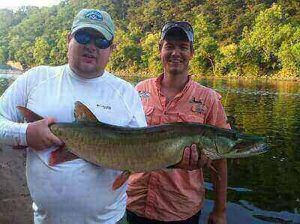
9. How you retrieve a lure depends on the water conditions and the activity levels of the fish. If the fish are active, use a rapid retrieve. For cold and warmer waters, use slower retrieves. As you learn to catch muskies, this is one of the best muskie fishing tips for beginners to remember.
10. When you get a positive response from the fish by following your bait or biting it, repeat that retrieval pattern throughout the day and when you encounter the same scenario.
11. Perform one figure-eight maneuver boat side at the end of each retrieval as muskies are known for stalking baits before striking. With the figure-eight maneuver, the change in direction usually triggers the reluctant fish and it buys time for the angler to notice a fish closing in on the bait.
12. Always use sharp hooks. Take with you a sharpening tool for large hooks since large hooks out of the package are usually dull. The hooks you use when fishing play an important role in being successful in fishing. This is one of the muskie fishing tips for beginners that is very important.
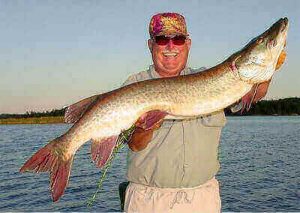
13. Only use a net if you intend to keep the fish. If you will use a net and plan to release the fish, the net should have rubber-coated bags to reduce the fish’s mucus loss. A deep net that is about 52 inches with an opening between 34 and 44 inches will work. Always net the muskie head first.
14. You will often find muskies around stumps, drop-offs, sand bars, weed edges, rock bars, rocky ledges, shady areas along the shorelines, and vegetation. They lurk around those structures waiting for their prey.
15. Muskies take both artificial and live bait.
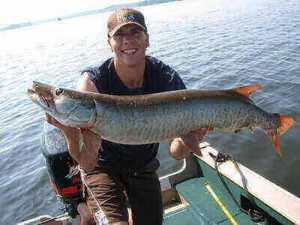
16. If you want to catch trophy muskies, Fall is the best time for them with September and October being the peak months.
17. Locate panfish and you will have determined the food source of muskies. Another clever way to figure this out is to watch out for panfish anglers. They will be in areas where panfish are in abundance. And that area with the abundance of panfish is the food source for muskies!
18. Don’t remain fixed on one lure presentation. Change lures often. Experiment with other presentations until you find the winner.
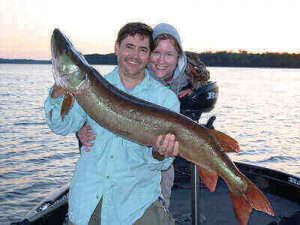
How To Catch Muskie From Shore
When fishing for muskie from the shore, the first thing is to lightly walk to the shore. Try to not take heavy steps and avoid making a lot of noise. Fish can feel the vibrations and hear the noise. If they are close to the shore and pick up the vibrations and noise, they will leave for cover.
Before casting from the shore, spend some time studying the water, looking for signs of life, and observing if any baitfish is nibbling at the surface of the water. Look for any structures that may be coming out of the water. Broken piers, docks, wrecks, fallen trees, logs, and poles are possible areas where fish may be hanging out.
Additionally, look for areas with shade from trees or other structures that may serve as places where fish may congregate to avoid the sun.
You can divide the body of water into three parts and work them. If you don’t get action in one-third, move to the next third. By moving, you will locate muskies. Cast baits or lures into the water and retrieve them.
Casting upriver for the lures to move with the current can yield good results. Fish will face into the current to catch baitfish coming that way and in their direction. When you work against the current, you will catch fish. Topwater lures work well when fishing from the shore.
Do this repeatedly until you get a bite. When there is a bite, set the hook in and retrieve it fast. Night fishing from the shore can also be done and sometimes it can be more productive than fishing during the day.
How To Catch Muskie In Summer
When fishing for muskies during the summer, look for structures and target those areas. Muskies will be found close to structures. Rocks, weed beds, and sand are some of the structures to target. Use baits that will go deeper into the water column
.
When you fish for muskies and don’t get action in one area, move to another area. One tactic is to divide the river, lake, or pond into three parts and fish them.
When fishing during the summer, pay attention to the wind. Wind can create currents that will set up muskies for feeding. keep your eyes open for current lines on the surface of the water. Fish will spread out when the water is calm but will congregate when it is windy, they will congregate in certain locations which will be ideal for fishing them.
Additionally, topwater lures work well in the summer. You can use them over very thick weeds and shallow rock cover and never spook the fish or disturb the zone. if the conditions become flat and the bite is slow, a jigging bait can be used. Cast it and jig it back. Night fishing during the summer is also very rewarding. Fish slowly and methodically at night using bucktails.
How To Catch Muskie In A River
When fishing for muskie in a river, you can cast bait and lures. Casting lures upriver allows the lures to move with the current. Fish like to face into the current as this position allows them to receive a lot of baitfish and other marine life that the current brings in that direction. Topwater lures work well during the summer.
Muskies migrate during spring and fall. They go into side channels and backwaters or remain on the downstream shoreline where there is not much current. This knowledge of their behavior can help you plan how you fish for them.
Cast your lures and baits in the side channels and backwater during spring and fall. Depending on the size of the river, you can also use trolling, jigging, drift fishing, and bottom fishing for muskies.
How To Catch Muskie In Winter
Winter is the time for vertical jigging. Vertical jigging can be very productive during the winter as muskies will go deep into the water column. When vertical jigging, you drop the line with the bait deep in the water column, closer to the bottom where you can fish muskies.
Then you pull the line vertically so the lure or bait appears to make a vertical motion. This gets the attention of fish and might entice them to bite.
During the winter, fishing for muskies is methodical and subtle as bites are not very violent. When jigging, you will be getting your bait into the faces of muskies and tempting them to bite. Trolling, bottom fishing, and baitcasting are other fishing methods that are used to catch muskies during the winter.
How To Catch Muskie Ice Fishing
Locating muskies is the first hurdle to overcome when ice fishing for them. Most of the time, muskies will be found in the same areas they were found during the fall. They will be close to the bottom in weed lines, channel breaks, points, shoreline bars, and inside turns.
Muskies move around in search of food so drilling many holes will improve your chances of locating them. Patience is required when fishing for muskies in the winter.
Jigging is one of the popular fishing methods anglers use when ice fishing for muskies. A jigging rod works well when jigging for muskie through the ice.
The other fishing method is a baited tip-up. For the tip-up fishing technique, use a live sucker minnow on a quick strike rig. A minnow about 6 inches in length will get the attention of a muskie under the ice.
How To Catch Muskie On Lake St. Clair
When fishing for muskies on St. Clair Lake, you need to find muskies. Trolling the lake with multiple lines will increase your chances of finding them. Casting, jigging, or trolling are the three fishing methods used by anglers when fishing for muskies on Lake St. Clair.
Muskie Fishing Gear
1. Fishing Line
A fishing line is an essential piece of gear for muskie fishing, known for its strength and durability to handle the powerful strikes and vigorous fights of these formidable predators. Anglers targeting muskies typically opt for heavy-duty fishing lines with high abrasion resistance, such as braided or fluorocarbon lines, to withstand the sharp teeth and rugged underwater terrain where muskies often reside.
Braided lines offer superior strength-to-diameter ratios, allowing anglers to cast heavy lures long distances and control large fish with greater ease. Fluorocarbon lines, on the other hand, provide excellent sensitivity and low visibility underwater, ideal for finesse presentations and stealthy approaches in clear water conditions. Regardless of the specific type chosen, a robust fishing line is crucial for muskie anglers to effectively handle the intense battles and land these prized freshwater predators.
2. Rods
A fishing rod is a critical piece of gear for muskie fishing, designed to handle the powerful strikes and aggressive fights of these large and elusive predators. Muskie rods are typically longer and heavier than traditional fishing rods, ranging from 7 to 9 feet in length and featuring stout blanks and sturdy construction to withstand the brute force exerted by these formidable fish.
The longer length allows anglers to make long casts and effectively work large lures through the water, while the heavy power rating provides the backbone needed to set the hook and control the fish during the battle. Muskie rods often feature specialized features such as reinforced guides, oversized reel seats, and comfortable grips to enhance durability and provide anglers with the leverage and control necessary to land these prized freshwater giants.
3. Reels
A fishing reel is an essential component of muskie fishing gear, playing a crucial role in casting, retrieving, and battling these powerful freshwater predators. Muskie reels are typically large and robust, capable of holding heavy lines and providing the strength and durability needed to handle the intense pressure exerted by these aggressive fish.
Baitcasting reels are commonly used for muskie fishing due to their ability to handle heavy lines and lures with ease, while also providing precise casting control and powerful drag systems to control the fish during the fight. Muskie reels often feature high gear ratios to quickly retrieve line and keep up with fast-moving muskies, as well as sturdy construction and corrosion-resistant materials to withstand the harsh freshwater environment.
Additionally, many muskie reels are equipped with large handles and ergonomic knobs to provide anglers with the comfort and leverage needed to handle these hard-fighting fish effectively.
4. Leaders
A leader is an essential component of muskie fishing gear, serving as a protective barrier between the main fishing line and the sharp teeth and abrasive mouth of these aggressive freshwater predators. Muskie leaders are typically made from heavy-duty materials such as fluorocarbon or steel wire to withstand the powerful strikes and sharp teeth of muskies.
The leader’s primary function is to prevent the muskie from cutting the fishing line with its teeth or thrashing against rocks or submerged structures during the fight, thereby increasing the angler’s chances of landing the fish successfully.
Additionally, leaders can also provide additional abrasion resistance when fishing in areas with rocky or snag-filled bottoms, helping to prevent line breaks and lost fish. Muskie leaders come in various lengths and strengths to accommodate different fishing situations and lure presentations, allowing anglers to customize their setups based on the specific conditions and behavior of the fish.
5. Heavy Tackle
Tackle is an indispensable component of muskie fishing gear, encompassing a diverse array of lures, baits, hooks, and other terminal tackles designed to entice and hook these elusive freshwater predators. Muskie tackle is typically characterized by its robust construction and large profile, tailored to withstand the powerful strikes and formidable jaws of muskies.
Common muskie lures include large bucktail spinners, jointed crankbaits, soft plastic swimbaits, and topwater lures like prop baits and walk-the-dog style plugs, each designed to mimic the natural prey of muskies and trigger aggressive strikes.
Additionally, muskie anglers often employ heavy-duty hooks, swivels, and snaps to ensure secure connections between the mainline and the lure, minimizing the risk of equipment failure during intense battles with these hard-fighting fish. With a wide range of tackle options available, muskie anglers can adapt their setups to target muskies in various habitats and conditions, increasing their chances of hooking into these prized freshwater gamefish.
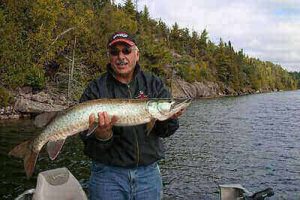
Musky Fishing Baits
1. “Figure 8”
The “Figure 8” technique is not a specific bait but rather a critical maneuver employed by muskie anglers to entice strikes from these elusive freshwater predators. After presenting a lure near the boat or the shoreline and initiating a retrieve, anglers use the “Figure 8” motion by making large, sweeping movements with the lure just below the water’s surface in a figure-eight pattern.
This technique mimics the erratic behavior of wounded prey, often triggering a muskie’s predatory instincts and prompting a strike. Anglers must maintain focus and precision during the “Figure 8,” as muskies may follow the lure closely but hesitate to strike until the last moment. Mastering the “Figure 8” technique is essential for increasing hookup rates and landing trophy-sized muskies, making it a cornerstone skill in the arsenal of any serious muskie angler.
2. Soft Plastics
Soft plastics are versatile and effective bait options for muskie fishing, offering anglers a wide range of sizes, shapes, and colors to match the preferences of these apex predators. Soft plastic lures such as swimbaits, tubes, grubs, and worms can be rigged in various ways, including Texas rigs, Carolina rigs, or jigheads, allowing anglers to fish them at different depths and in diverse water conditions.
These baits often feature lifelike swimming actions and realistic textures that closely mimic the movement of natural prey, enticing muskies to strike. Anglers can experiment with different retrieves, speeds, and presentations to find the most effective technique for enticing strikes from these elusive fish.
Soft plastics are particularly effective when targeting muskies in cover-rich environments such as weed beds, submerged timber, or rocky structures, where their weedless designs and snag-resistant properties help navigate through dense cover without getting hung up. With their versatility and lifelike appearance, soft plastics are essential components of any muskie angler’s tackle box.
3. Bucktails
Bucktails are renowned among muskie anglers as one of the most effective and versatile bait options for targeting these formidable predators. Consisting of a lead jighead adorned with a skirt of deer hair or synthetic fibers, bucktails offer a lifelike appearance and enticing action in the water.
The pulsating motion of the skirt mimics the movement of baitfish, triggering aggressive strikes from muskies. Anglers can customize bucktails by choosing different colors and sizes to match prevailing water conditions and the preferences of the fish. Additionally, bucktails can be modified with additional trailers or soft plastic bodies to enhance their profile and swimming action.
When retrieved, bucktails create a commotion in the water, drawing muskies from a distance and provoking instinctual strikes. They are particularly effective when worked along weed edges, rocky structures, and other prime muskie habitat. With their versatility, durability, and proven effectiveness, bucktails are a staple in the tackle boxes of muskie anglers seeking trophy-sized fish.
4. Glide Baits
Glide baits have become increasingly popular among muskie anglers due to their ability to mimic the erratic and evasive movements of injured or fleeing prey. These lures typically feature a slender, elongated body with a jointed construction that allows them to “glide” smoothly through the water when retrieved.
The side-to-side action of glide baits closely resembles the swimming motion of baitfish, making them irresistible to muskies on the hunt. Anglers can manipulate the retrieve speed and rod twitches to impart lifelike movements, enticing strikes from even the most cautious predators.
Glide baits are particularly effective when fished over submerged weed beds, along rocky shorelines, and near structure-rich areas where muskies lurk in wait for their next meal. With their realistic appearance and enticing action, glide baits have earned a reputation as a go-to option for targeting trophy-sized muskies in both clear and murky waters.
5. Topwaters
Topwater lures are renowned for their ability to elicit explosive strikes from muskies, making them a thrilling and effective choice for anglers targeting these apex predators. These lures are designed to float on the surface of the water, creating enticing commotion and vibrations that mimic the movements of injured or struggling prey.
Anglers typically work topwaters with a rhythmic “walk-the-dog” retrieve, causing the lure to dart back and forth enticingly across the surface. The resulting splashes and commotion often trigger aggressive strikes from muskies lurking below.
Topwater baits excel in shallow waters, over submerged weed beds, and near the edges of lily pads or other structure-rich areas where muskies frequently ambush their prey. Whether it’s a noisy propeller-style bait, a sleek walk-the-dog lure, or a lifelike frog imitation, topwaters provide anglers with an exhilarating and effective approach to enticing strikes from these formidable freshwater predators.
6. Crankbaits
Crankbaits are a staple in the muskie angler’s arsenal, valued for their versatility and ability to cover water efficiently while enticing aggressive strikes. These lures typically feature a hard plastic body with a lip at the front that causes them to dive to specific depths when retrieved.
Muskie crankbaits come in various shapes, sizes, and diving depths to suit different conditions and preferences. Anglers often choose crankbaits with large profiles and robust construction to withstand the powerful strikes of muskies. With their tight wobble or erratic action, crankbaits mimic the movements of wounded baitfish, making them irresistible to muskies.
Anglers can vary their retrieval speed and depth to explore different parts of the water column, from shallow flats to deeper drop-offs and weed edges, effectively locating active fish. Whether trolling along a broken line or casting around structure, crankbaits are a reliable option for enticing strikes from muskies in a wide range of fishing situations.
7. Swimbaits
Swimbaits have become increasingly popular among muskie anglers for their lifelike appearance and enticing swimming action. These large soft plastic lures mimic the movement of natural prey, such as baitfish or larger forage species, making them a favorite choice for targeting trophy muskies.
Swimbaits come in various sizes, shapes, and colors to match the local forage and fishing conditions. Some feature jointed bodies that impart a realistic swimming motion, while others have paddle tails that create vibration and movement as they are retrieved through the water. Anglers often rig swimbaits on heavy-duty jig heads or swimbait hooks to ensure they can handle the powerful strikes of muskies and withstand the rigors of aggressive fishing.
Whether retrieved steadily or with pauses and twitches, swimbaits can be effective in enticing strikes from muskies lurking in weed beds, along rocky shorelines, or near submerged structures. With their versatility and lifelike action, swimbaits have earned their place as go-to lures for muskie anglers seeking to tempt these apex predators.
The Bottom Line
Muskies are one of the sought-after fish by anglers. They pose a challenge for anglers as they are elusive and big. In this article, we discuss how to catch muskies by sharing muskie fishing tips for beginners.
Whether you are a beginner or an experienced muskie fisherman, we hope you will learn how to catch more muskies from the muskie fishing tips shared. If you want to catch more fly fish, this article about fly fishing tips will be a good read. You can also read bluegill fishing tips, pike fishing tips, and redfish fishing tips.
